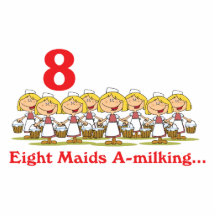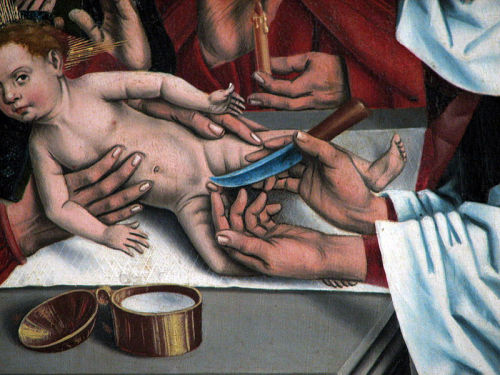Read the ramblings of Dr. Caligari. Hopefully you will find that Time does wound all heels. You no longer need to be sad that nowadays there is so little useless information.
Tuesday, January 1, 2013
Another year older
Hopefully you didn't enjoy your New Year's Eve celebration too much. I don't want to overtax your brain this morning so, here's some stuff, you may not know -
Today's gift count (120 gifts): you currently have Eight young woman engaged in the dairy industry, 14 Swans making a racket, 18 geese a' laying (fertilized goose eggs are going for about $82 per dozen), 20 golden rings, 20 calling birds, 18 French hens, 14 turtledoves and 8 partridges in their respective pear trees.
Remember to think kindly of women who work in the dairy industry - if it weren't for the unnatural interest Edward Jenner took in milk maids, we would never have the smallpox vaccine.
The Feast of the Circumcision of Our Lord is a Christian celebration of the circumcision of Jesus, eight days (according to the Semitic and southern European calculation of intervals of days) after his birth,
the occasion also celebrates the date on which the child was formally given his name, Jesus, a name derived from Hebrew meaning salvation or savior.
Tonight is the Seventh and last night of Kwanzaa.
Tonight celebrates Imani (Faith) - To believe with all of one's heart in one's people, one's parents, one's teachers, one's leaders and the righteousness and victory of one's struggle.
January 1, 1898 -
New York City annexes land from surrounding counties, creating the City of Greater New York.
The four initial boroughs, Manhattan, Brooklyn, Queens and The Bronx, are joined on January 25 by Staten Island to create the modern city of five boroughs.
If you didn't get your Farmer's Almanac this year or suffer from lycanthropy, here is your guide to the Full Moons of 2013
January 27 - The Full Wolf Moon. Amid the zero cold and deep snows of midwinter, the wolf packs howled hungrily outside Indian villages. In London, impeccably dressed werewolves are often seen on the prowl in search of a dish of beef chow mein (and their hair is perfect.)
It was also known as the Old Moon or the "Moon After Yule." In some tribes this was the Full Snow Moon; most applied that name to the next Moon.
February 25 - The Full Snow Moon. Usually the heaviest snows fall in this month. Hunting becomes very difficult, and hence internet traffic increases threefold.
Some tribes also referred to this Moon as the Full Hunger Moon, since harsh weather conditions in their areas made hunting very difficult.
March 27 - The Full Worm Moon. In this month the ground softens and the earthworm casts reappear, inviting the return of the robins. Just what you want to think about in the morning - worm crap. The more northern tribes knew this Moon as the Full Crow Moon, when the cawing of crows signaled the end of winter; or the Full Crust Moon, because the snow cover becomes crusted from thawing by day and freezing at night. The Full Sap Moon, marking the time of tapping maple trees, is another variation.
To the settlers, it was also known as the Lenten Moon, and was considered to be the last full Moon of winter.
April 25 - The Full Pink Moon. The grass pink or wild ground phlox is one of the earliest widespread flowers of the spring.
Other names were the Full Pink Floyd Moon because remember - there is no dark side of the moon - it's all dark.
May 25 - The Full Flower Moon. Flowers are abundant everywhere. Usually at your local Korean deli around the corner.
Other names include the Full Corn Planting Moon, or the Milk Moon (in a few months, the moon will be full of cheese.)
June 23 - The Full Strawberry Moon. This name was universal to every Algonquin tribe. However, in Europe they called it the Rose Moon. Also because the relatively short season for harvesting strawberries comes each year during the month of June . . . so the full Moon that occurs during that month was christened for the strawberry!
Best seen in Central Park, across from the Dakota.
July 22 - The Full Buck Moon, when the new antlers of buck deer push out from their foreheads in coatings of velvety fur. Again another disgusting image - bone pushing through flesh - for your early morning.
It was also often called the Full Thunder Moon, for the reason that thunderstorms are most frequent during this time. Another name for this month's Moon was the Full Hay Moon.
August 21 - The Full Sturgeon Moon, when this large fish of the Great Lakes and other major bodies of water like Lake Champlain is most readily caught. Sometimes, a sort of lunar madness occurs during this cycle, when people might chase the full moon with a little chopped egg and sour cream. Please direct these poor souls to Zabar's.
A few tribes knew it as the Full Red Moon because, as the Moon rises, it appears reddish through any sultry haze. It was also called the Green Corn Moon or Grain Moon.
September 19 - The Full Harvest Moon. Always the full Moon occurring nearest to the Autumnal Equinox.
This is the time of year, aging Canadian Rock stars will sing full out with their once achingly beautiful harmonies.
October 19 - The Full Hunter's Moon. With the leaves falling and the deer fattened, it is time to hunt.
Since the fields have been reaped, hunters can ride over the stubble, and can more easily see the fox, also other animals that have come out to glean and can be caught for a thanksgiving banquet after the harvest.
November 17, - The Full Beaver Moon (OK stop snickering.) Time to set beaver traps before the swamps freeze to ensure a supply of warm winter furs. Another interpretation suggests that the name Beaver Full Moon comes from the fact that the beavers are now active in their preparation for winter.
It is sometimes also referred to as the Frosty Moon. (Really stop laughing.)
December 17 - The Full Cold Moon (or the Full Long Nights Moon.) In this month the winter cold fastens its grip, and the nights are at their longest and darkest. Also sometimes called the "Moon before Yule" (Yule is Christmas, and this time the Moon is only just before it).
The term Long Night Moon is a doubly appropriate name because the midwinter night is indeed long, and because the Moon is above the horizon for a long time. The midwinter full Moon has a high trajectory across the sky because it is opposite a low Sun. Rudolph sometimes gets the night off because of the bright light.
And so it goes.
Subscribe to:
Post Comments (Atom)




No comments:
Post a Comment